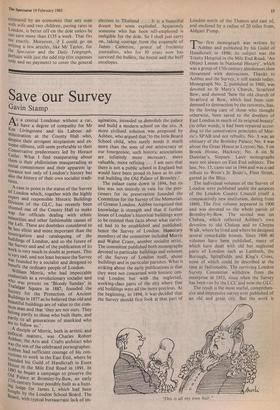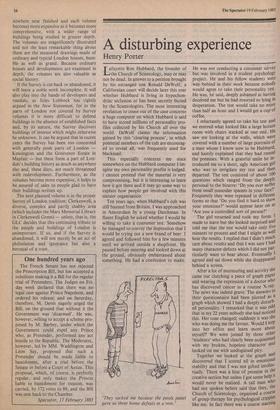Save our Survey
Gavin Stamp
As a central Londoner without a car, I have a degree of sympathy for Mr Ken Livingstone and his Labour ad- ministration at the County Hall who, despite their arrogant utopianism and ex- treme silliness, still seem preferable to their Conservative predecessors led by Horace Cutler. What I find exasperating about them is their philistinism masquerading as 'ig-
norance commitment and their apparent ig- norance not only of London's history but also the history of their own socialist tradi- tions.
A case in point is the status of the Survey of London which, together with the highly expert and responsible Historic Buildings Division of the GLC, has recently been
shunted out of the County Hall to make waY for officials dealing with ethnic minorities and other fashionable causes of the Left. These are doubtless considered to be less elitist and more important than the investigation and cataloguing of the buildings of London, and so the future of the Survey and and of the publication of its work is very much in doubt at present. This is very sad, and not least because the Survey
was founded by a socialist and designed to benefit the ordinary people of London.
William Morris, who had impeccable credentials as a revolutionary socialist and
who was present on 'Bloody Sunday' in
Trafalgar Square in 1887, founded the `3,,c3cietY for the Protection of Ancient beautiful in 1877 as he believed that old and beautiful buildings are of value to the com- mon man and that 'they are not ours. They belong Partly to those who built them, and Partly to all generations of mankind who are to follow us.'
A disciple of Morris, both in artistic and Political matters, was Charles Robert Ashbee, the Arts and Crafts architect who was the son of the celebrated pornographer.
Ashbee had sufficient courage of his con- victions to work in the East End, where he founded his Guild of Handicraft in Essex 11, Ouse in the Mile End Road in 1891. In 293 he began a campaign to preserve the Palace at Bromley-by-Bow, an early 17th-century house possibly built as a hunt- ing lodge for James I, which had been 17oght by the London School Board. The oard, with typical bureaucratic lack of im-
agination, intended to demolish the palace and build a modern school on the site. A more civilised solution was proposed by Ashbee, who argued that 'to the little Board School child, who surely needs it much more than the sons of our aristocracy or our bourgeoisie, such historic associations are infinitely more necessary, more valuable, more refining ... I am sure that there is not a public school in England but would have been proud to have as its cen- tral building the Old Palace of Bromley.'
The palace came down in 1894, but its loss was not entirely in vain for the peti- tioners for its preservation founded the Committee for the Survey of the Memorials of Greater London. Ashbee recognised that knowledge is strength and that if further losses of London's historical buildings were to be resisted then facts about what surviv- ed had to be established and published: hence the Survey of London. Honorary members of the committee included Morris and Walter Crane, another socialist artist. The committee published both monographs devoted to particular buildings and volumes of the Survey of London itself, about buildings and in particular parishes. What is striking about the early publications is that they were not concerned with historic cen- tral London but with the neglected, working-class parts of the city where fine old buildings were all the more precious. At the beginning, in 1894, it was decided that the Survey should first look at that part of London north of the Thames and east of, and enclosed by a radius of 20 miles from, Aldgate Pump.
rr he first monograph was written by 1 Ashbee and published by his Guild of Handicraft in 1896; its subject was the Trinity Hospital in the Mile End Road, 'An Object Lesson in National History', which was a group of 17th-century almshouses then threatened with destruction. Thanks to Ashbee and the Survey, it still stands today. Monograph No. 2, published in 1900, was devoted to St Mary's Church, Stratford Bow, and showed 'how the old church of Stratford at Bow, which had been con- demned to destruction by the restorers, has, by the loving care of those who thought otherwise, been saved to the dwellers of East London in much of its original beauty' (in other words, it had been repaired accor- ding to the conservative principles of Mor- ris's SPAB and not rebuilt). No. 3 was an obituary of the Bromley Palace; No. 4 was about the Great House at Leyton; No. 5 on Brook House, Hackney; No. 6 on St Dunstan's, Stepney. Later monographs were not always on East End subjects. The last, No. 15, came out in 1944 and was a sad tribute to Wren's St Bride's, Fleet Street, gutted in the Blitz.
The individual volumes of the Survey of London were published under the auspices of the London County Council (itself a comparatively new institution, dating from 1888). The first volume appeared in 1900 and was devoted to the whole parish of Bromley-by-Bow. The second was on Chelsea, which reflected Ashbee's own devotion to old Chelsea and to Cheyne Walk, where he lived and where he designed several remarkable houses. Since 1900 40 volumes have been published, many of which have dealt with old but neglected parts of London such as Lambeth, the Borough, Spitalfields and King's Cross, none of which could be described at the time as fashionable. The surviving London Survey Committee withdrew from the enterprise in 1953, since when the Survey has been run by the LCC and now the GLC.
The result is the most useful, comprehen- sive and impressive survey ever published of an old and great city. But the work is
'This is all my own hair.'
nowhere near finished and each volume becomes more expensive as it becomes more comprehensive, with a wider range of buildings being studied in greater depth. The volumes are magnificently illustrated and not the least remarkable thing about them are the measured drawings made of ordinary and typical London houses, hum- ble as well as grand. Because ordinary houses and developments are examined in depth, the volumes are also valuable as social history.
If the Survey is cut back or abandoned, it will leave a noble work incomplete. It will also play into the hands of developers and vandals, as Jules Lubbock has rightly argued in the New Statesman, for in the parts of London not covered by Survey volumes it is more difficult to defend buildings in the absence of established facts and, by its nature, the Survey discovers buildings of interest which might otherwise be unknown. It can be argued that in recent years the Survey has been too concerned with generally posh parts of London Kensington and the Grosvenor Estate in Mayfair — but these form a part of Lon- don's building history as much as anywhere else and, these days, are much threatened with redevelopment. Furthermore, as the volumes become more expensive, it helps to be assured of sales to people glad to have their buildings written up.
The next planned volume is in the proper Survey of London tradition: Clerkenwell, a diverse, complex and partly shabby area (which includes the Marx Memorial Library in Clerkenwell Green) — unless, that is, the GLC decides that this continuing tribute to the people and buildings of London is unimportant. If so, and if the Survey is abandoned, it will not merely be an act of philistinism and ignorance but also a betrayal of a trust.







































 Previous page
Previous page